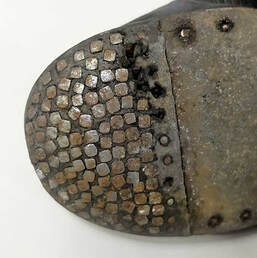|
Welcome back to our series all about the evolution of Irish dance costuming! While we’ll cover the sparkly dresses Irish dance is known for next week, this week is all about the most important aspect of any Irish dancer’s performance: the feet! (Or, more specifically, the shoes!) Before the mainstream introduction of ghillies (Irish dance lace-up soft shoes) in the 1920s, most woman danced barefoot or in whatever shoes they normally wore. But the precursor to modern ghillies is much, much older than that! Inhabitants of the Aran Islands in Co. Galway have always been master craftsman, and are the original inventors of the first version of the ghillies we know today. For thousands of years, Aran Islanders made and wore shoes made of a single piece of untanned leather, which was then gathered around the toes and cinched close to the foot with laces crossed up the top of the shoes (see image—looks familiar, doesn’t it?) These shoes were coined “pampooties” sometime in the 16th century (though Irish oral history means it’s unclear if the term was new or not,) and they were known for their flexibility. While untanned leather would generally stiffen up on its own, the fishing villages on the island and Ireland’s generally damp climate allowed the shoes to stay flexible. However, without proper treatments to preserve the leather, pampooties were only usable for about a month before the shoe simply rotted away.  The weight of those nails really adds up! The weight of those nails really adds up! It’s unclear how pampooties became the more modern, treated version of ghillies (it’s also the origin of Scottish Highland dance shoes, also known as ghillies, but with some small differences,) but today the shoes are made of supple, black kid leather made to mold to the dancer’s foot over time. The laces are much longer, with loops of leather to lace all the way up the top of the foot, around the arch, and then tied around the ankle. In modern Irish dance, only female dancers wear the shoes we know as ghillies, while men’s soft shoes have a construction more similar to modern jazz shoes—but with a special addition! Men’s soft shoes are called reel shoes include a raised heel with “clicks”—fiberglass heels the dancers are able to utilize to create precise sounds (which means different choreography than female soft shoes dances!) Conversely, the earliest version of hard shoes (otherwise known as heavy shoes or jig shoes) were, well, regular shoes! Dancers wore their everyday boots and brogues to dance for years, but they were always adding modifications to increase the volume of their steps. Irish dance has always been inextricably tied to music and the quick rhythm of the steps is what makes it unique—so making the shoes louder when they strike the floor has always been desirable. Originally, this effect was achieved by hammering tons of nails into the sole of the shoe, and making hardened, raised heels by stacking many layers of stiff leather together. As I’m sure you can guess, the shoes were indeed loud, but also incredibly heavy!  Modern Irish dance ghillies, with a pair of modern, fiberglass hard shoes at the end Modern Irish dance ghillies, with a pair of modern, fiberglass hard shoes at the end It wasn’t until the 1980s that the world of Irish dance embraced new methods for creating hard shoes. Even though fiberglass was invented in early 1930s, it took most of a century for Irish dace shoe makers to embrace it and figure out how to use it to create a lighter, more durable shoe. This invention allowed Irish dance to continue to progress into the 21st century, as the lightness of the shoe allowed for leaps and bounds (pun intended) in the types of choreography dancers are able to perform! Without all those nails and stiff leather weighing them down, Irish dance was able to take its place on the world stage and move from cultural dance form to the highly athletic and artistic sport it is today! Next week we’ll continue on into the 21st century and learn about how the image of an Irish dancer we know today came into being from these origins! This post is part of a series. Take a look at our last "Origins of Irish Dance" post, all about the history of female costuming, here. Also: check out the blog every Monday and Thursday for more posts about Irish history, dance culture, community news, and spotlights on our dancers, staff, and families—among other fun projects! And don’t forget to dance along with us on both Facebook and Instagram.
0 Comments
Your comment will be posted after it is approved.
Leave a Reply. |
SRL NewsFind all of our latest news on our Scoil Rince Luimni Facebook page! Categories
All
Archives
August 2022
|
 RSS Feed
RSS Feed